山西省晋中市2018届高三1月高考适应性调研考试英语试卷(含答案)
【高三英语试题精选】山西省2018年高考考前适应性训练英语试题
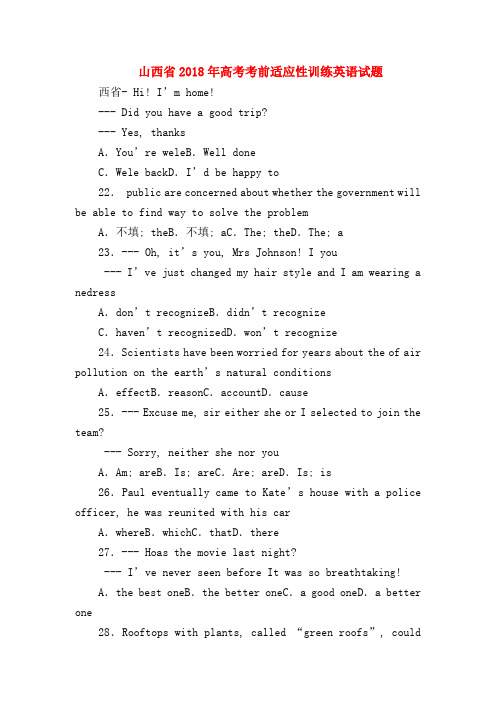
A.howeverB.whicheverC.whateverD.whenever
第二节完型填空(共that money can buy
Indian call-center employers, Russian engineers, Chinese middle managers, and Brazilian salespeople are already searching the web for information on trips They want to see Paris from the Eiffel Tower, relax in the Maldives, and play blacack in Las Vegas According to the United Nations World Tourism Organization, international tourist visits are expected to double soon, from roughly 800 million in long waiting lists will cause the creation and expansion of tourist attractions in both developed and developing countries
28.Rooftops with plants, called“green roofs”, could help fight global warming
A.to coverB.being cov.the fact that he is a millionaire now, the man still lives a simple life as before
【英语】山西省晋中市2018届高三1月高考适应性调研考试英语试题
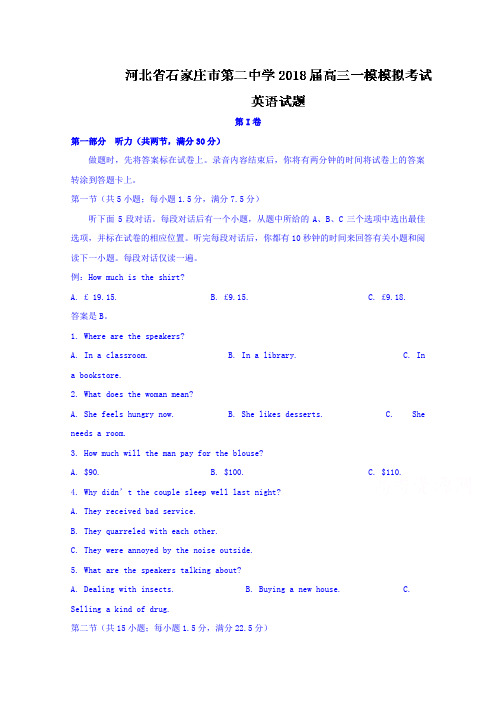
名人幽默笑话最新集锦名人幽默笑话一葛优请朋友吃饭一次,葛优请朋友吃饭,中途上了趟厕所,回来时,裤子湿了一大块。
朋友:你的裤子怎么湿啦?葛优:自从我成名之后经常这样。
朋友:经常这样?葛优:可不是!经常是旁边的人撒着尿突然转过来大叫:“这不是葛优吗!我还以为是马放的呢布什去英国访问,女王举行盛大欢迎仪式。
到处都铺上了红地毯,女王陪着布什乘坐六匹大马拉着的鎏金马车走在夹道欢迎的人群中,显得极为尊贵,想到在美国谁都敢骂总统,布什不禁赞叹不已。
忽然一匹拉车的马放了一个又响又臭的屁,布什为了不使女王尴尬,装作没有注意,仍然对着欢迎人群招手致意。
女王觉得不好意思,对布什抱歉地说:“对不起,有些事就是女王也控制不了。
”布什哈哈一笑说:“你要是不提,我还以为是马放的呢?英女王和美国总统布什到英国访问,布什总统由于不懂礼节,曾在依丽沙白女王的国宴上出了好些个洋相.比如在宴会开始时女王向布什端起酒杯示意准备演奏美国国歌,而总统先生以为是女王向他敬酒,刚端起酒杯回应,却不想女王却又将酒杯放下,然后又一本正经地坐着一动不动了。
为这,布什总统一夜没睡好。
第二天一早,依丽沙白女王邀请布什总统到她的庄园去,刚上马车,前面的马儿“噗”的一声放了一个屁。
过了一会儿,女王陛下出于礼貌,对布什说,“不好意思。
”总统先生心不在焉地说道:“我还以为是马放的呢!”调侃王小丫开心词典节目主持人王小丫现场采访一位节目观众,问:“在你心目中你最崇拜哪个女主持人?”观众说:“是你呀。
”王小丫问:“为何如此说?”观众说:“因为你长得有点像杨澜!”鲁迅先生的保姆鲁迅先生家的两个保姆,不知何故,发生了口角。
先生受不了整日的吵闹,竟病倒了。
隔壁的小姑娘不解地问:"先生,你为什么不喝止她们呢?" 鲁迅先生笑着说:"她们闹口角,是因为彼此心里都有气,口角虽然可以暂时压下去了,但心里有气是压不下去的,恐怕也要失眠。
与其三个人都失眠或者两个人失眠,那么还不如让我一个人失眠算了总统库利奇美国前总统卡尔文•库利奇夫妇在参观一个农场时,两人分开参观。
山西省2018届高三第一次模拟考试 英语
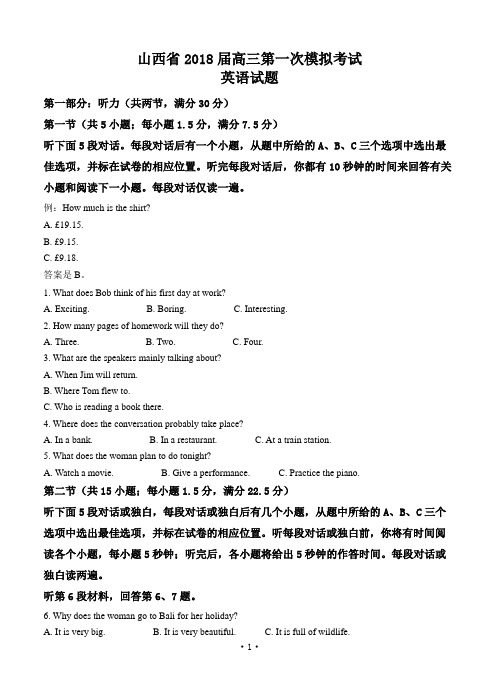
山西省2018届高三第一次模拟考试英语试题第一部分:听力(共两节,满分30分)第一节(共5小题;每小题1.5分,满分7.5分)听下面5段对话。
每段对话后有一个小题,从题中所给的A、B、C三个选项中选出最佳选项,并标在试卷的相应位置。
听完每段对话后,你都有10秒钟的时间来回答有关小题和阅读下一小题。
每段对话仅读一遍。
例:How much is the shirt?A. £19.15.B. £9.15.C. £9.18.答案是B。
1. What does Bob think of his first day at work?A. Exciting.B. Boring.C. Interesting.2. How many pages of homework will they do?A. Three.B. Two.C. Four.3. What are the speakers mainly talking about?A. When Jim will return.B. Where Tom flew to.C. Who is reading a book there.4. Where does the conversation probably take place?A. In a bank.B. In a restaurant.C. At a train station.5. What does the woman plan to do tonight?A. Watch a movie.B. Give a performance.C. Practice the piano.第二节(共15小题;每小题1.5分,满分22.5分)听下面5段对话或独白,每段对话或独白后有几个小题,从题中所给的A、B、C三个选项中选出最佳选项,并标在试卷的相应位置。
听每段对话或独白前,你将有时间阅读各个小题,每小题5秒钟;听完后,各小题将给出5秒钟的作答时间。
【英语】山西省2018届高三考前适应性测试英语试题 (1)
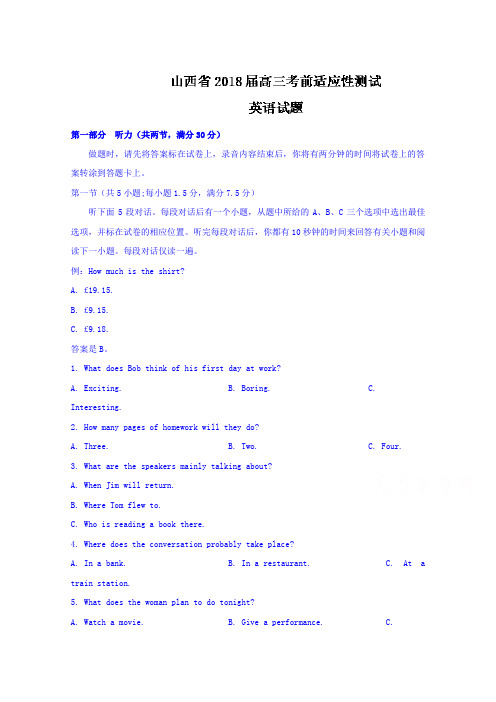
第一部分听力(共两节,满分30分)做题时,请先将答案标在试卷上,录音内容结束后,你将有两分钟的时间将试卷上的答案转涂到答题卡上。
第一节(共5小题;每小题1.5分,满分7.5分)听下面5段对话。
每段对话后有一个小题,从题中所给的A、B、C三个选项中选出最佳选项,并标在试卷的相应位置。
听完每段对话后,你都有10秒钟的时间来回答有关小题和阅读下一小题。
每段对话仅读一遍。
例:How much is the shirt?A. £19.15.B. £9.15.C. £9.18.答案是B。
1. What does Bob think of his first day at work?A. Exciting.B. Boring.C. Interesting.2. How many pages of homework will they do?A. Three.B. Two.C. Four.3. What are the speakers mainly talking about?A. When Jim will return.B. Where Tom flew to.C. Who is reading a book there.4. Where does the conversation probably take place?A. In a bank.B. In a restaurant.C. At a train station.5. What does the woman plan to do tonight?A. Watch a movie.B. Give a performance.C.Practice the piano.第二节(共15小题;每小题1.5分,满分22.5分)听下面5段对话或独白。
每段对话或独白后有几个小题,从题中所给的A、B、C三个选项中选出最佳选项,并标在试卷的相应位置。
2018高考适应性模拟考试英语答案
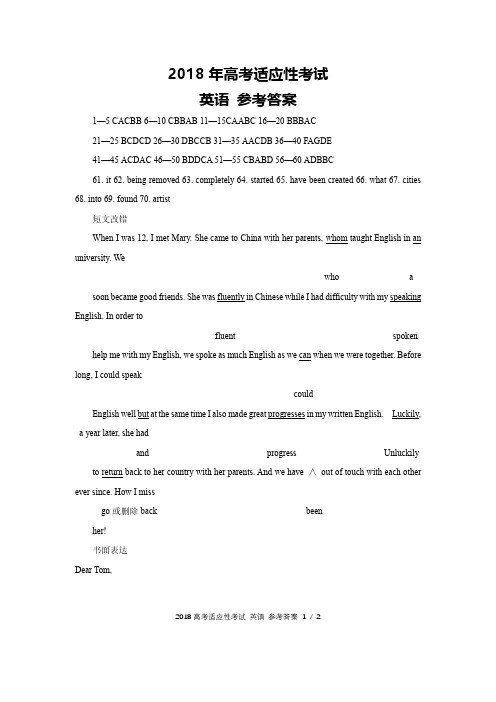
2018年高考适应性考试英语参考答案1—5 CACBB 6—10 CBBAB 11—15CAABC 16—20 BBBAC21—25 BCDCD 26—30 DBCCB 31—35 AACDB 36—40 FAGDE41—45 ACDAC 46—50 BDDCA 51—55 CBABD 56—60 ADBBC61. it 62. being removed 63. completely 64. started 65. have been created 66. what 67. cities 68. into 69. found 70. artist短文改错When I was 12, I met Mary. She came to China with her parents, whom taught English in an university. Wewho a soon became good friends. She was fluently in Chinese while I had difficulty with my speaking English. In order tofluent spoken help me with my English, we spoke as much English as we can when we were together. Before long, I could speakcouldEnglish well but at the same time I also made great progresses in my written English. Luckily, a year later, she hadand progress Unluckily to return back to her country with her parents. And we have ∧out of touch with each other ever since. How I missgo或删除back beenher!书面表达Dear Tom,2018高考适应性考试英语参考答案1/ 2How are you doing? I am writing to invite you to participate in the activity, called Campus Culture Day. It will be held in our school hall on December 10th. It is expected to last from 9:00 a. m. to 5:00 p. m. The purpose of this activity is to show our rich campus culture and the students’ various talents. And at the same time, we hope our students’ cultural awareness will be strengthened through this activity.On that day there will be many performances such as folk dancing, folk and classic music, Poetry Reading and so on. I think it will be an unforgettable day in our life.Looking forward to your attendance.Yours,Li Hua2018高考适应性考试英语参考答案2/ 2。
2018届山西省高三第一次模拟考试英语试题
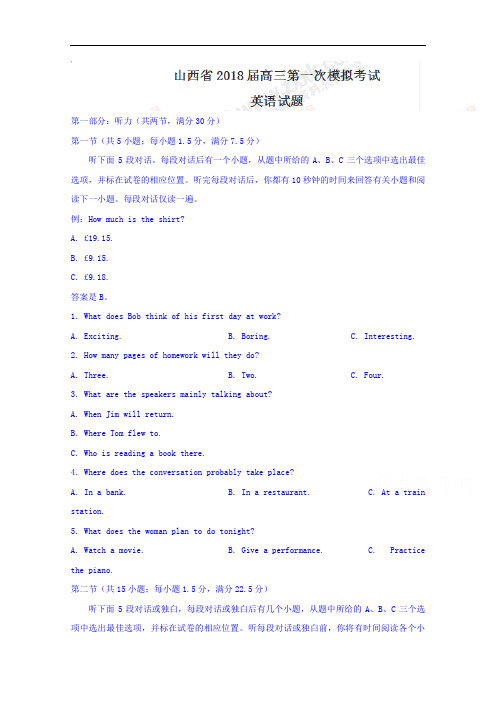
第一部分:听力(共两节,满分30分)第一节(共5小题;每小题1.5分,满分7.5分)听下面5段对话。
每段对话后有一个小题,从题中所给的A、B、C三个选项中选出最佳选项,并标在试卷的相应位置。
听完每段对话后,你都有10秒钟的时间来回答有关小题和阅读下一小题。
每段对话仅读一遍。
例:How much is the shirt?A. £19.15.B. £9.15.C. £9.18.答案是B。
1. What does Bob think of his first day at work?A. Exciting.B. Boring.C. Interesting.2. How many pages of homework will they do?A. Three.B. Two.C. Four.3. What are the speakers mainly talking about?A. When Jim will return.B. Where Tom flew to.C. Who is reading a book there.4. Where does the conversation probably take place?A. In a bank.B. In a restaurant.C. At a train station.5. What does the woman plan to do tonight?A. Watch a movie.B. Give a performance.C. Practice the piano.第二节(共15小题;每小题1.5分,满分22.5分)听下面5段对话或独白,每段对话或独白后有几个小题,从题中所给的A、B、C三个选项中选出最佳选项,并标在试卷的相应位置。
听每段对话或独白前,你将有时间阅读各个小题,每小题5秒钟;听完后,各小题将给出5秒钟的作答时间。
2018届高考英语适应性考试试题
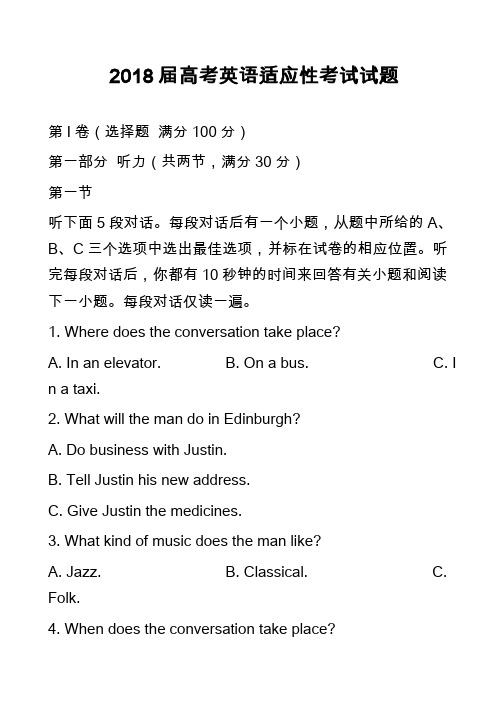
2018届高考英语适应性考试试题第I卷(选择题满分100分)第一部分听力(共两节,满分30分)第一节听下面5段对话。
每段对话后有一个小题,从题中所给的A、B、C三个选项中选出最佳选项,并标在试卷的相应位置。
听完每段对话后,你都有10秒钟的时间来回答有关小题和阅读下一小题。
每段对话仅读一遍。
1. Where does the conversation take place?A. In an elevator.B. On a bus.C. I n a taxi.2. What will the man do in Edinburgh?A. Do business with Justin.B. Tell Justin his new address.C. Give Justin the medicines.3. What kind of music does the man like?A. Jazz.B. Classical.C. Folk.4. When does the conversation take place?A. In September.B. In April.C. In February.5. Whose advice did the woman follow?A. The shop assistant’s.B. Her mother’s.C. Her sister’s.第二节听下面5段对话或独白。
每段对话或独白后有几个小题,从题中所给的A、B、C三个选项中选出最佳选项,并标在试卷的相应位置。
听每段对话或独白前,你将有时间阅读各个小题,每小题5秒钟;听完后,各小题将给出5秒钟的作答时间。
每段对话或独白读两遍。
听下面一段对话,回答第6和第7两个小题。
6. What are the speakers mainly discussing?A. Where to buy tickets.B. Where to park the car.C. Where to get a camera.7. Where will the speakers meet?A. At the market.B. At the camera shop.C. At t he sports stadium.听下面一段对话,回答第8和第9两个小题。
山西省晋中市2018届高三1月高考适应性调研考试英语试卷(扫描版)

2018年1月高考适应性调研考试英语测试答案及评分标准(B卷)第一部分听力(共20小题;每小题1.5分,满分30分)1~5 BCACB 6~10 ACCAA 11~15 BACBA 16~20 CCBAA第二部分阅读理解(共两节,满分60分)第一节(共15小题;每小题3分,满分45分)21~24 DBDA 25~27 CAC 28~31 ABAC 32~35 CBAB第二节(共5小题;每小题3分,满分15分)36~40 AFCDE第三部分英语知识运用(共两节,满分55分)第一节完形填空(共20 小题;每小题2分,满分40分)41~45 ACBCD 46~50 ACBAB 51~55 DCBAC 56~60 DDCAB第二节(共10小题;每小题1.5分,满分15分)61. who/that 62. better 63. hardly 64. complained 65. was offered66. the 67. off 68. to hire 69. It 70. Having experienced第四部分写作(共两节,满分35分)第一节短文改错(共10小题;每小题1分,满分10分)Once upon a time, there lived eighty thousands elephants at the bottom of the Himalayas. ItsthousandTheirleader was a white elephant. He greatly loved his mother who has grown blind and could nothadlook after herself. Each day this white elephant would go deeply into the forest to look for the bestdeepfood for her, and he asked another elephant to send it to his mother. Therefore, his mother neverHoweverreceived some. Each night, when he returned home he would∧surprised to hear that his mother any behad been starving all day.One day, he took his mother to Mount Candorana to live in a cave beside the beautiful lake.aWhen the white elephant was feeding, he heard loud cries. A forester from Benaras had lost histerrifiedas he could. The elephant asked the forester that why he was crying so bitterly. The forester said that he could not find his way out.第二节书面表达(满分25分)One possible version:Dear Simon,I’m glad to know that you will come to China during your vacation. First of all, I’d like to express my warmest welcome. You’ve mentioned that a native guide is wanted and I’m writing to recommend my brother Li Ming to you.Li Ming, a graduate from Beijing University, is outgoing, enthusiastic and always ready to help others. What makes him more suitable is that he has a great passion for traveling and has a good knowledge of Chinese tourist attractions. Besides, he stands out for his fluent spoken English, so you have no difficulty communicating with each other. I’m sure he can offer you an unforgettable trip.Looking forward to your coming.Yours,Li Hua。
【高三数学试题精选】2018届高三英语1月高考适应性调研考试试卷(晋中市含答案)

2018届高三英语1月高考适应性调研考试试卷(晋中市含答案)5 c 西省晋中市高三1月高考适应性调研考试英语试题第一部分听力(共两节,满分30分)第一节(共5小题; 每小题15分,满分75分)听下面5段对话。
每段对话后有个小题,从题中所给的A、B、c 三个选项中选出最佳选项。
听完每段对话后,你都有10秒钟的时间回答有关小题和阅读下一小题。
每段对话仅读一遍。
1 here are the taling st prbabl?A In a useuB In a cinea c In a lab2 H an siing classes are there this ter?A FiveB Eight c Thirteen3 hat is Alice rried abut?A Her brtherB Her final exas c Her accident4 h is ac?A enn’s husbandB ar’s husband c enn’s ld clleague5 h des the an reect the b?A It is l-paidB It is far fr his hec It ffers n hlida第二节(共15小题;每小题15分,满分25分)听下面5段对话或独白。
每段对话或独白后有几个小题,从题中所给的A、B、c 三个选项中选出最佳选项。
听每段对话或独白前,你将有时间阅读各个小题,每小题5秒钟;听完后,各小题将给出5秒钟的作答时间。
每段对话或独白读两遍。
听第6段材料,回答第6、7题。
6 h did the an ve?A T live in a bigger huseB T live clser t her ffice。
山西省2018届高三第一次模拟考试 英语
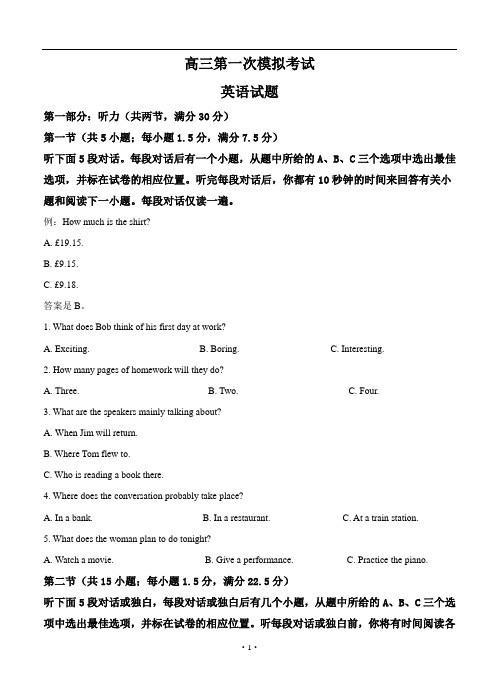
高三第一次模拟考试英语试题第一部分:听力(共两节,满分30分)第一节(共5小题;每小题1.5分,满分7.5分)听下面5段对话。
每段对话后有一个小题,从题中所给的A、B、C三个选项中选出最佳选项,并标在试卷的相应位置。
听完每段对话后,你都有10秒钟的时间来回答有关小题和阅读下一小题。
每段对话仅读一遍。
例:How much is the shirt?A. £19.15.B. £9.15.C. £9.18.答案是B。
1. What does Bob think of his first day at work?A. Exciting.B. Boring.C. Interesting.2. How many pages of homework will they do?A. Three.B. Two.C. Four.3. What are the speakers mainly talking about?A. When Jim will return.B. Where Tom flew to.C. Who is reading a book there.4. Where does the conversation probably take place?A. In a bank.B. In a restaurant.C. At a train station.5. What does the woman plan to do tonight?A. Watch a movie.B. Give a performance.C. Practice the piano.第二节(共15小题;每小题1.5分,满分22.5分)听下面5段对话或独白,每段对话或独白后有几个小题,从题中所给的A、B、C三个选项中选出最佳选项,并标在试卷的相应位置。
听每段对话或独白前,你将有时间阅读各个小题,每小题5秒钟;听完后,各小题将给出5秒钟的作答时间。
【高三英语试题精选】2018届高三英语一诊试题(含答案听力)
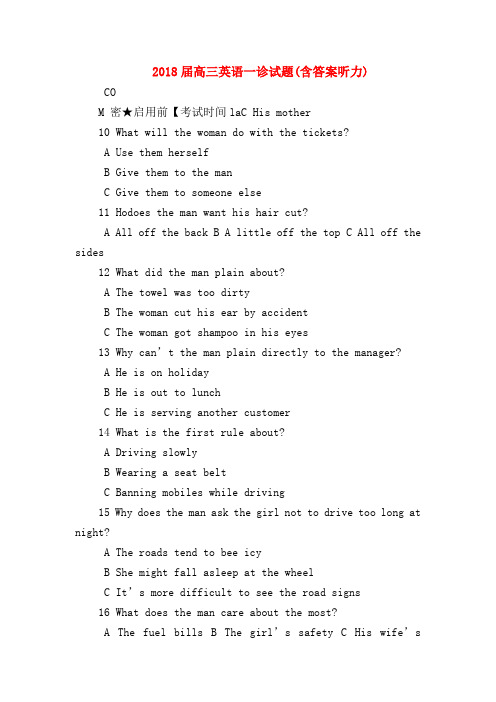
2018届高三英语一诊试题(含答案听力)
CO
M 密★启用前【考试时间laC His mother
10 What will the woman do with the tickets?
A Use them herself
B Give them to the man
C Give them to someone else
23 Which is true about the Simple Savings Card?
A It is health insurance
B It is a discount program
C It can be used with insurance car
D It is accepted in hospitals
11 Hodoes the man want his hair cut?
A All off the back B A little off the top C All off the sides
12 What did the man plain about?
A The towel was too dirty
2018山西一模英语答案
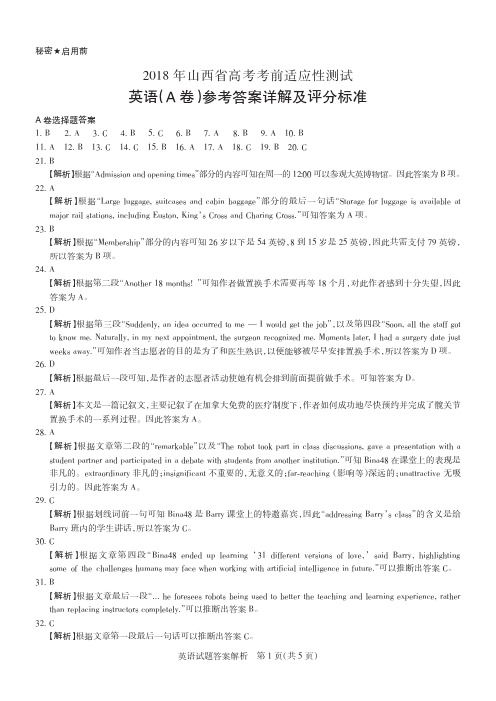
秘密★启用前2018年山西省高考考前适应性测试英语(A卷)参考答案详解及评分标准A卷选择题答案1.B2.A3.C4.B5.C6.B7.A8.B9.A10.B11.A12.B13.C14.C15.B16.A17.A18.C19.B20.C21.B【解析】根据“Admission and opening times”部分的内容可知在周一的12:00可以参观大英博物馆。
因此答案为B项。
22.A【解析】根据“Large luggage,suitcases and cabin baggage”部分的最后一句话“Storage for luggage is available at major rail stations,including Euston,King’s Cross and Charing Cross.”可知答案为A项。
23.B【解析】根据“Membership”部分的内容可知26岁以下是54英镑,8到15岁是25英镑,因此共需支付79英镑,所以答案为B项。
24.A【解析】根据第二段“Another18months!”可知作者做置换手术需要再等18个月,对此作者感到十分失望,因此答案为A。
25.D【解析】根据第三段“Suddenly,an idea occurred to me—I would get the job”,以及第四段“Soon,all the staff got to know me.Naturally,in my next appointment,the surgeon recognized me.Moments later,I had a surgery date just weeks away.”可知作者当志愿者的目的是为了和医生熟识,以便能够被尽早安排置换手术,所以答案为D项。
26.D【解析】根据最后一段可知,是作者的志愿者活动使她有机会排到前面提前做手术。
可知答案为D。
中2018届高三考前适应性训练英语试题(二)(附答案)(1)

中2018届高三考前适应性训练英语试题(二)(附答案)(1)银川一中2018届高三考前适应性训练---英语试题2第Ⅰ卷(选择题)第一部分:听力理解(略)第二部分:阅读理解(共两节,满分40分)第一节(共15小题;每小题2分,满分30分)阅读下列短文,从每题所给的A、B、C和D四个选项中,选出最佳选项。
AThroughout the country there are festivals and special events celebrating winter at its fullest, including hockey and dog sled races, skating events and whatever season-inspired activity draws in the crowds.Rossland Winter Carnivallate JanuaryRossland, British Columbia (BC)Recognized as canada's longest-running winter carnival (狂欢), the Rossland Winter Carnival has been a popular event for over 116 years. Popular parts of this event include snow volleyball, a parade, and a kid's carnival.Ice On Whyte Festivalearly January to early FebruaryEdmonton, Alberta (AB)A popular event for more than decade,the Ice on Whyte Festival in Edmonton, is one of the top10 events and festivals in Edmonton, Alberta. The festival features a wealth of ice carvings and creations along with 10 daysof festival fun-from a giant ice slide, games, and ice carving lessons to live music, fashion, food, and culturally themed days and even a marketplace.Fete des Neiges de Montrealmid January to early FebruaryMontreal, Quebec (QC)Celebrating more than 30 years as a popular winter event, it offers all sorts of fun involving everything from snow to ice on three nonstop weekends at the beginning of the year. Highlights include 15 snow slopes for breathtaking tube sliding, dog sledding, and even addictive dancing at the disco-themed La Bouletheque.Winterprideend January to early FebruarWhistler, British Columbia (BC)The 26th Whistler Pride will be filled with celebration of annual events with adventurous winter activities including ski and snowboard touring, snowmobile trips, and snowshoe adventures, dog-sledding through the Callahan Valley,and back-country ventures, as well as featuring nightlife highlights of drag shows, as well as wine-tastings, fine dining and even comedy shows.21. Where will you go if you like art works from ice?A. Whistler. British Columbia.B. Montreal, Quebec.C. Edmonton. Alberta.D. Rossland. British Columbia.22. What is the feature of the event in Montreal?A. It provides kinds of activities on ice or snow.B. It takes place three weeks at the start of a year.C. It offers dog sledding to tourists for nothing.D. It lasts the longest time of all the events.23. Which will be chosen for a person who like wine?A. Rossland Winter CarnivalB. Ice On Whyte FestivalC. Fete des Neiges de MontrealD. WinterPrideBOne of the hardest parts of living abroad is being away from your loved ones, especially your family. While my friends are so important to me, I’ve personally found it more difficult being away from family.However, I was fortunate that my mum and sister recently found the time to see me. Both my sister and I have major birthdays this year as she's tuming 18 and I'll be 21. My sister is a very big music fan and this year, I created my status as the best older sister by keeping an eye out for music concerts in Paris. In our home town of Leicester, we don’t regularly get many well-known artists playing in our city. But in Paris, I managed to get the best 18th birthday present of all: tickets for all three of us to see my sister’s favorite American rapper, Angel Haze.I will try to visit for my sister’s actual birthday in June, the chance for my sister and my mum to visit became a birthday treat. The experience of finding our way together to the concert or getting to show them around the Paris sites such as the Eiffel Tower,the Arc du Triomphe and even my favorite ice cream place,Amorino, was an amazing memory for us all !Despite the fact that I felt the slight pressure to make sure the weekend went smoothly,even the heavy rain failed to dampen our mood.Therefore, while it can be difficult being away from home and potentially missing big family moments,there are ways to avoidthe sadness and find a way to make the best of your situation to create an unforgettable memory. Just like the continuing rain while we went up the Eiffel tower, every cloud has a silver lining, because then we got the funniest photos ever!24.What can be known about the author while living abroad?A.She knew her friends were all homesick.B.She realized friends were more important.C.She somewhat missed her parents and siblings.D.She knew she she do her best to study.25.What do you know about the author from the second paragraph?A.She disliked the dull and dry life in her hometown.B.She in fact loved music no less than her sister.C.She thought American rapper was the most popular.D.She showed deep love for her younger sister.26.What does the underlined word“dampen”mean in the passage?A.Inspire.B.Damage.C. Protect.D. Remind.27.How does the author describe herself in the passage?A.She is easy to be homesick.B.She is responsible for her family.C.She has a positive attitude.D.She is skilled in taking photos.CMost of us have been in this situation: You're on your way to your friend's house, then you suddenly ask yourself,"Did I remember to turn the lights off?” For those with "smart homes",however, this wouldn’t be a problem.Over the last few years,smart home technology has become more popular. Thanks to user-friendly products like intelligent lighting and heating controllers, people can control nearly every electrical item in their homes from anywhere in the world.While smart homes aren't new, companies like Philips, Amazon and Xiaomi have finally brought automation to everyday people with affordable products like artificial intelligence(AI) speakers and sensors.“The obvious message is that you can stop wasting energy,” Tom Kerber, director of research for U. S -based digital company Parks Associates, told The Guardian.And the technology also has more meaningful uses. In Norway, for example, one company is using smart tech to make life easier for its elderly customers. Abilia's system allows carers to check up on patients through a tablet on a wall inside their home. The device sends patients reminders about tasks, such as when they need to take medication(冥想). It can even tell carers if there's any unusual activity in the home that could be life-threatening.“This ki nd of syste m allows people to take care of themselves, which is the most important thing,” Abilia's vice president, Oystein Johnsen, told the BBC. "It also saves the government money. In Norway, it costs 1 million kroner(about 0.8 million yuan )per year to have someone in a care home. This system costs 15,000 kroner a year.”So, for those who have already "gone smart", will it ever be possible to go back to do things in the old-fashioned way? "I think it would be difficult. When we go to a friend’s house o r on vacation we find ourselves expecting the house to do thingsfor us that we should do, "Poulson, 35,a senior program manager from Seattle.,U. S.,explained.28. What are the first and second paragraphs used for?A.Introducing the topic.B.Describing the situation.C.Advertising smart homes.D.Putting forward the author's opinion.29. What do Philips, Amazon and Xiaomi have in common?A.They are all designing smart homes.B.They are all U. S -based digital company.C.They've all advanced in smart technology.D.They've all received affordable products automatically.30. What does Abilia's system allow users to do in Norway?A.To take care of themselves.B.To buy user-friendly products.C.To control heating and cooling.D.To switch lights through a tablet.31. what's Poulson's attitude to smart technology?A.Cautious.B.FavorableC.Ambiguous.D.Disapproving.DBamboo is one of the world's most useful plants. For thousands of years, bamboo has been used in many different ways-from food to medicine to clothing and, in small ways, as a building material.However, bamboo is not often used as a building material in the developed world. A professor at the University of Pittsburgh in Pennsylvania is trying to change that. The professor and hisstudents are testing the strength of bamboo.They are testing how much pressure or weight it can take before breaking.Kent Harries is a professor at the University of Pittsburgh. Harries says that testing methods for bamboo need to be the same for all. They need to be standardized. Standardizing test methods for bamboo will help to bring the plant into common use. It will also give engineers and builders around the world a dependable standard.Harries says that bamboo is strong in nature. The strength of at least three species of bamboo is similar to steel.Besides its strength, bamboo has other features that make it very useful in building. He says it is resilient(有弹力的), meaning it keeps its shape and strength even under pressure.Bamboo also grows quickly. Bamboo that is suitable for construction needs much less resources than wood. The harvest cycle of bamboo is about 3 years. Softwoods such as cedar, pine and spruce have a harvest cycle of about 10 years. And hardwoods that come from flowering plants such as oak and walnut need more than 30 years.Bamboo is widely used as food for panda bears. It is also used for flooring and window covers. However, for building, bamboo is not used much outside its native growing area. This is mostly because of its round shape. But there are other reasons too. People think -- or have the mentality--that bamboo is a low quality building material.32.What is the author mainly talking about in the passage?33. A. Make bamboo a common building material.34. B. Take advantage of bamboo in our everyday.35. C. Consider bamboo to be a common plant.36. D. Use bamboo to replace building materials.37.33. What is the purpose of what Kent Harries and his students did?38. A. To prove what is the most useful plant.39. B. To introduce bamboo to the developed world.40. C. To give engineers and builders some advice.41. D. To make sure of the strength of bamboo.42.34. What does Harries think of bamboo in the passage?43. A. Harries sees bamboo as a great building material.44. B. Harries thinks bamboo is as strong as steel.45. C. Harries sees bamboo as the most ideal Plant.46. D. Harries thinks bamboo has the reliable shape.35. What can be inferred from the passage?A. Bamboo Is an environmentally friendly building material.B. Bamboo material will go to the market in the soon future.C. Hardwoods are much more popular than softwoods.D. Bamboo grows not only faster but takes up less space.第二节(共5小题,每小题2分,满分10分)根据短文内容,从短文后的选项中选出能填入空白处的最佳选项。
2018年山西省高三考前适应性测试英语试题有答案 (1)
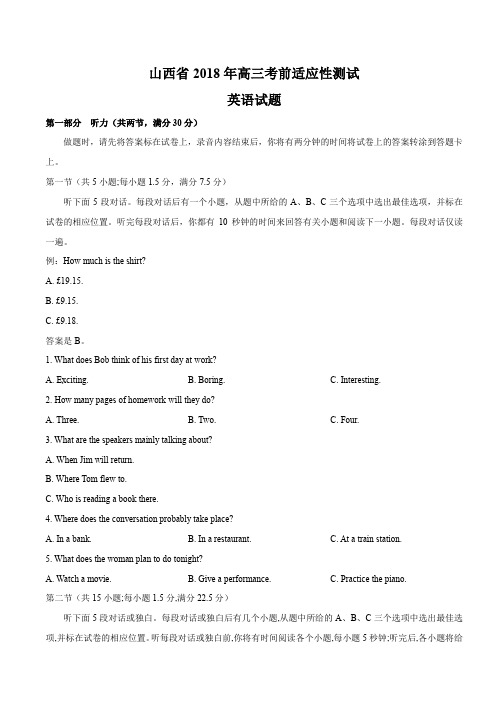
山西省2018年高三考前适应性测试英语试题第一部分听力(共两节,满分30分)做题时,请先将答案标在试卷上,录音内容结束后,你将有两分钟的时间将试卷上的答案转涂到答题卡上。
第一节(共5小题;每小题1.5分,满分7.5分)听下面5段对话。
每段对话后有一个小题,从题中所给的A、B、C三个选项中选出最佳选项,并标在试卷的相应位置。
听完每段对话后,你都有10秒钟的时间来回答有关小题和阅读下一小题。
每段对话仅读一遍。
例:How much is the shirt?A. £19.15.B. £9.15.C. £9.18.答案是B。
1. What does Bob think of his first day at work?A. Exciting.B. Boring.C. Interesting.2. How many pages of homework will they do?A. Three.B. Two.C. Four.3. What are the speakers mainly talking about?A. When Jim will return.B. Where Tom flew to.C. Who is reading a book there.4. Where does the conversation probably take place?A. In a bank.B. In a restaurant.C. At a train station.5. What does the woman plan to do tonight?A. Watch a movie.B. Give a performance.C. Practice the piano.第二节(共15小题;每小题1.5分,满分22.5分)听下面5段对话或独白。
每段对话或独白后有几个小题,从题中所给的A、B、C三个选项中选出最佳选项,并标在试卷的相应位置。
英语_2018年山西省晋中市高考英语模拟试卷(1月份)_
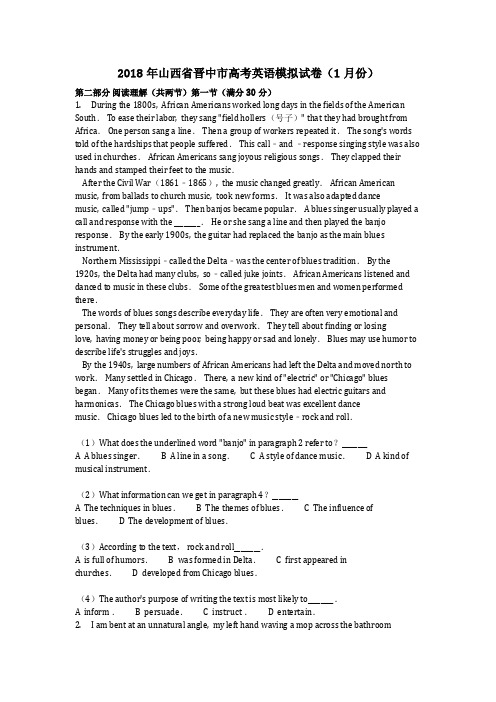
2018年山西省晋中市高考英语模拟试卷(1月份)第二部分阅读理解(共两节)第一节(满分30分)1. During the 1800s, African Americans worked long days in the fields of the American South. To ease their labor, they sang "field hollers(号子)" that they had brought from Africa. One person sang a line. Then a group of workers repeated it. The song's words told of the hardships that people suffered. This call﹣and ﹣response singing style was also used in churches. African Americans sang joyous religious songs. They clapped their hands and stamped their feet to the music.After the Civil War(1861﹣1865), the music changed greatly. African American music, from ballads to church music, took new forms. It was also adapted dance music, called "jump﹣ups". Then banjos became popular. A blues singer usually played a call and response with the ________. He or she sang a line and then played the banjo response. By the early 1900s, the guitar had replaced the banjo as the main blues instrument.Northern Mississippi﹣called the Delta﹣was the center of blues tradition. By the1920s, the Delta had many clubs, so﹣called juke joints. African Americans listened and danced to music in these clubs. Some of the greatest blues men and women performed there.The words of blues songs describe everyday life. They are often very emotional and personal. They tell about sorrow and overwork. They tell about finding or losinglove, having money or being poor, being happy or sad and lonely. Blues may use humor to describe life's struggles and joys.By the 1940s, large numbers of African Americans had left the Delta and moved north to work. Many settled in Chicago. There, a new kind of "electric" or "Chicago" blues began. Many of its themes were the same, but these blues had electric guitars and harmonicas. The Chicago blues with a strong loud beat was excellent dancemusic. Chicago blues led to the birth of a new music style﹣rock and roll.(1)What does the underlined word "banjo" in paragraph 2 refer to?________A A blues singer.B A line in a song.C A style of dance music.D A kind of musical instrument.(2)What information can we get in paragraph 4?________A The techniques in blues.B The themes of blues.C The influence of blues.D The development of blues.(3)According to the text, rock and roll________.A is full of humors.B was formed in Delta.C first appeared inchurches. D developed from Chicago blues.(4)The author's purpose of writing the text is most likely to________.A inform .B persuade.C instruct .D entertain.2. I am bent at an unnatural angle, my left hand waving a mop across the bathroomfloor, my right hand grasping a hair straightener. As I catch sight of myself in themirror, the stupidity of the situation strikes me. But I go on with them, convinced I'm getting the most from my early morning minutes.We live in a world of multitasking﹣where the measure of a person is how many jobs they can perform at the same time. Yet, is multitasking a good idea? "We've done a number of studies that prove people who multitask frequently suffer a lot, "Dr Nass Clifford at Stanford University says. "They're less able to recognize useless information, they're less able to pay attention, and they are worse at managing their memory."Psychologist Dr Sherry Turkle, a Massachusetts Institute of Technology professor, holds the view that in some situations, the loss that we get with multitasking is harmless, "Butyou can't do serious work this way." Of course. There are some things we can do________. We can talk while walking, or eat dinner while watching TV. This is because each task requires a different type of brain activity. So, reading while listening to instrumental music is fine, but the ability to concentrate on words on a page decreases sharply when listening to music with lyrics, because both actions rely on the part of the brain that deals with language.So what about my need to multitask? Perhaps both my hair and my bathroom floor would end up better off if each received some individual attention. Of course they would, but I have to take the first step and learn to self﹣management my time better. "It takes a huge amount of discipline, and people find it really difficult, " says Dr Nass, "But that doesn't men it's not a great thing to do."(1)From what the author does in the morning, we know that she________.A thinks she is wasting time.B gets a feeling of satisfaction.C wants to save time.D is enjoying herself.(2)According to the studies done by the experts at Stanford University,________.A multitasking is not a good idea.B we can't do two things at the sametime. C multitasking can improve people's memory. D those who are able to multitask are quick﹣minded.(3)The underlined word "simultaneously" in paragraph 5 probably means________.A quickly.B independently.C at the same time.D without difficulty.3. The Earth's temperature is rising. And as it does, springtime phenomena﹣like thefirst bloom of flowers﹣are getting earlier and earlier. But rising temperatures aren't the only factor. Urban light pollution is also quickening the coming of spring. "So temperature and light are really contributing to a double whammy of making everything earlier. " Richard Ffrench﹣Constant, an entomologist at the University of Exeter.He and his colleagues compiled 13 years of data from citizen scientists in theU. K. , who tracked the first bud(芽) burst of four common trees. Turns out, light pollution﹣from streetlights in cities, and along roads﹣pushed bud burst a full week earlier. Way beyond what rising temperatures could achieve. This disruptive(干扰性的)timing can ripple through the ecosystem.The caterpillars that feed on trees are trying to match the hatching of their eggs to thetiming of bud burst. Because the caterpillars want to feed on the juiciest and least chemically protected leaves. And it's not just the caterpillars, of course, that are important. But the knock﹣on effect is on nesting birds, which are also trying to hatch their chicks at the same time that there's the maximum number of caterpillars. So earlier buds could ultimately affect the survival of birds, and beyond. The findings are in the Proceedings of the Royal Society B.The world's becoming increasingly urbanized, and light pollution is growing﹣which Richard says could trick trees into budding earlier and earlier. But smarter lighting﹣like LEDs that dial down certain wavelengths﹣could help. "Perhaps the exciting thing is, if we understand more about how light affects this bud burst, we might be able to devise smarter sort of street lighting that has less red components, and therefore less early bud burst. Thus it is possible to keep springtime an actual springtime phenomenon. " Richard add.(1)How did Richard and his colleagues reach the conclusion?________A By analyzing some data.B By observing nature closely.C By doing a lot of experiments.D By keeping track of four common trees.(2)Why do the caterpillars hatch eggs at the same time of bud burst?________A To protect young leaves.B To get high quality food.C To give birth to healthy babies.D To avoid being the meals of birds.(3)How does Richard feel about the actual springtime phenomenon?________A It's promising.B It's amusing.C It's costly.D It's challenging.(4)What may be the best title for the next?________A The Rising Temperature of the Earth.B Ways of Reducing Urban Light Pollution.C City Lights Quickening the Coming of Spring.D The Effect of the Earlier Spring on the Ecosystem.4. Kobe Bryant, the former US National Basketball Association league star, launches a $100 million venture capital fund known as Bryant Stibel at the New York Stock Exchange. Mr Bryant, 37, the former captain of the Los Angeles, retired from basketball earlier last year after a 20﹣year career. He told The Wall Street Journal he felt he had a talent for identifying entrepreneurs(企业家). Mr Stibel is an entrepreneur and investor(投资者)who founded several companies including Web.com. Mr Bryant has invested with Mr Stibel before, but this fund is the first formal partnership between them. The pair are financing the fund themselves. Since 2013, they have invested in 15 companies together including sports website The Players Tribune, video game designer Scopely, and legal services company Legal Zoom. The "Bryant Stibel" fund will invest in tech, media and data companies.Mr Bryant, who was known for his strong work ethic(道德) inbasketball, said, "Similar skills are needed for sport and growing a business. It's the inner belief that a person has that he will bear no matter what the obstacle may be. It's a strong will that makes the entrepreneur do what he or she truly believes in and truly loves to do."The pair said the fund would last a few years and look to target companies where they felt they could add vale through their business insight, and not through Mr Bryant's celebrity (名人). Mr Stibel told The Wall Street Journal, "We don't want to be in the business of investing in others' companies, where someone can use Kobe as an endorser(代言人). That's not interesting. The point is to add real value."(1)What can we know about Bryan Stibel?________A It has invested in tech and media.B It was created the moment Koberetired. C Its fund is provided by Kobe and Stible. D It is the first cooperation between Kobe and Stible.(2)What does Kobe think matters in running a business?________A Enthusiasm.B Determination.C Partnership.D Intelligence.(3)Why did the pair want to set up the fund?________A To add value to some companies.B To invest in the companies in trouble.C To take advantage of Mr Kobe's celebrity.D To contribute to the development of sports.(4)What type of writing is this text?________A A sport event.B A news report.C An interview.D A biography.第二节(满分10分)根据短文内容,从短文后的选项中选出能填入空白的最佳选项.选项中有两项为多余选项.5. Although many young people expect to go to college, they don't want to be an exchange student, worried that if they go to a foreign land, they won't know how to get around and will look and feel like tourists constantly.(1)_______In the majority of cases, people who become exchange students love the time they spent in a foreign country, especially when they went to a country that they had some interest in.(2)_______Many who come back from an exchange trip say that the thing they loved the most was learning about the different lifestyles that people live in the country that was visited.(3)_______But those who travel to other countries under the foreign exchange student program learn that there are many different ways to live.Some students are worried that they won't like the cuisine of the country that they go to.(4)_______ Can you imagine eating a fresh pastry in France? How about some real Italian food in Italy? Being an exchange student often leads one to find that they enjoy a much wider variation of cuisines than they originally thought they did.Some decide that the language barrier is the key to keeping them from going anywhere as an exchange student.(5)_______And even if you go to a non﹣English﹣speaking country many people there know how to speak English enough to allow you to communicate without too much problem. You can enjoy the chance to learn about different cultures and their languages.If you are coming up with reasons to avoid going anywhere as an exchange student, thinkabout the many benefit you'll get from a trip abroad before you make up your mind.A. This, however, isn't the case.B. Most young people decide to go to college to have new experiences.C. Many in the United States believe that our way of life is the only way of life.D. The truth is that most countries that allow for exchange students have amazing food.E. Actually, there are many places that you can go where English is the native language.F. If you decide to be an exchange student, there are tons of things that you can learn and enjoy.G. Before you choose to study abroad, think carefully about the country that you wish to study in.第三部分英语知识运用(共两节)第一节完形填空(满分30分)阅读下面短文,从短文后各题所给的A、B、C和D四个选项中,选出可以填入空白处的最佳选项.6. Michele Allen has had many dogs over the years. But a 13﹣pound shelter dog with heart problems and bad teeth(1)_______her life forever.Monkey was a foster dog, and Allen and her husband took care of him for the last few months of his(2)_______. "Monkey's death was really(3)_______on us, "Allen said."We knew what we were getting into, and we decided to just(4)_______him as much as we could."As Allen learned that so many older, terminally﹣ill dogs like Monkey were being euthanized(安乐死) in(5)_______, she decided to open her six﹣acre (6)_______ to them.Since 2015, her nonprofit﹣which she (7)_______ named Monkey's House﹣has provided a (8)_______place where dozens of dogs have spent their (9)_______ days. Allen said most people think a dog hospice (善终医院) would be a sad place.(10)_______she calls it "the happiest place on earth.""We're very busy(11)_______them a story, alife, adventures, love, and special moments, "she said. Allen(12)_______around 25 dogs at a time. All dogs get home﹣cooked meals (13)_______their medical needs, with individual meal(14)_______created by the organization's veterinarian(兽医).The dogs also(15)_______.herbs and natural supplements. Around 50 (16)_______help Allen and her husband, Jeff, care for the dogs. Allen says someone is always cooking, doing laundry, (17)_______dogs or preparing medication."It's extremely important to me that we not (18)_______ them in their final moments, " she said. "I want them to have a very gentle (19)_______, and I want them feeling as loved and (20)_______ as they can be. "(1)A changedB destroyedC completedD devoted(2)A experienceB progressC lifeD cooperation(3)A terrifyingB hardC regretfulD surprising(4)A defendB feedC loveD teach(5)A dozensB rowsC groupsD shelters(6)A farmB yardC platformD ring(7)A reasonablyB patientlyC affectionatelyD deliberately(8)A entertainingB lovingC convenientD comfortable(9)A finalB equalC importantD exhausting(10)A BecauseB ButC AndD So(11)A takingB editingC writingD giving(12)A accounts forB waits forC cares forD hunts for(13)A separated fromB based onC enveloped inD escaped from(14)A plansB decisionsC purposesD attempts(15)A selectB storeC receiveD collect(16)A cooksB doctorsC nursesD volunteers(17)A huggingB kissingC comfortingD Walking(18)A beatB comfortC failD help(19)A passingB landingC encouragingD treating(20)A neededB supportedC praisedD welcome第二节(每小题1.5分,满分15分)阅读下面短文,在空白处填入1个适当的单词或括号内单词的正确形式.7. Father was a hardworking man (1)________delivered bread as a living to support his wife and three children. He spent all his evenings after work attending classes, hoping to improve himself so that he could one day find a (2)________(good) paid job. Except for Sundays, Father (3)________(hardly) ate a meal together with his family.Whenever the family(4)________ (complain) that he was not spending enough time with them, he reasoned that he was doing all this for them. Soon after, he (5)________(offer) a good job which paid handsomely.He continued to work very hard, hoping to be promoted to (6)________position of manager. So he enrolled for another course in the open university. Father's hard work paid(7)________and he was promoted. So he decided(8)________(hire) a maid to relieve his wife from her domestic tasks.(9)________was necessary for his family to enjoy a comfortable life.(10)________(experience) the rewards of his hard work many times before, Father resolved to further his studies and work at being promoted again.第四部分写作(共两节)第一节短文改错(满分10分)8. 假定英语课上老师要求同桌之间交换修改作文,请你修改你同桌写的以下作文.文中共有10处语言错误,每句中最多有两处.每处错误仅涉及一个单词的增加、删除或修改.增加:在缺词处加一个漏词符号(/\),并在其下面写出该加的词.删除:把多余的词用斜线(\)划掉.修改:在错的词下画一横线,并在该词下面写出修改后的词.注意:1.每处错误及其修改均仅限一词;2.只允许修改10处,多者(从第11处起)不计分.Once upon a time, there lived a herd of eighty thousands elephants at the bottom of the Himalayas. Its leader was a white elephant. He greatly loved his mother who has grown blind and feeble and could not look out for herself. Each day this white elephant would go deeply into the forest to look for the best food for her, and he asked another elephant to send it to his mother. Therefore, his mother never received some. Each night, when he returned home he would surprised to hear that his mother had been starving all day.One day, he took his mother to Mount Candorana to live in a cave beside the beautiful lake. When the which elephant was feeding, he heard loud cries. A forester from Benaras had lost his way in the forest. On seeing the big white elephant he was even moreterrifying and ran as fast as he could. The elephant asked the forester that why he was crying so bitterly. The forester said that he could not find his way out.第二节:书面表达(25分)9. 假定你是李华,你Facebook的好友Simon将于假期期间来中国旅游,请你帮忙找一名向导.请给他写一封邮件推荐你的哥哥李明,内容包括:1.李明简介;2.推荐理由.注意:1.词数100左右;2.可以适当增加细节,以使行文连贯.________________________________________________2018年山西省晋中市高考英语模拟试卷(1月份)答案1. DBDA2. CAC3. ABAC4. CBAB5. A,F,C,D,E6. ACBCDACBABDCBACDDCAB7. who/that,better,hardly,complained,was offered,the,off,to hire,It,Having experienced8. Once upon a time, there lived a herd of eighty thousands elephants at the bottom of the Himalayas.Its leader was a white elephant.He greatly loved his mother who has grown blind and feeble and could not look out for herself. Each day this white elephant would go deeply into the forest to look for the best food for her, and he asked another elephant to send it to his mother.Therefore, his mother never received some. Each night, when he returned home he would∧ surprised to hear that his mother had been starving all day.One day, he took his mother to Mount Candorana to live in a cave beside the beautiful lake. When the which elephant was feeding, he heard loud cries. A forester from Benaras had lost his way in the forest. On seeing the big white elephant he was even more terrifying and ran as fast as he could. The elephant asked the forester that why he was crying so bitterly. The forester said that he could not find his way out.解析1.thousands﹣﹣﹣ thousand.考查固定的用法.根据修饰词eighty可知,用thousand.有具体的数字时,千百万等词不用复数.2. Its﹣﹣﹣Their.考查代词.代指a herd of eighty thousands elephants 用Their修饰leader.3.has ﹣﹣﹣ had.考查谓语动词的时态.根据He greatly loved his mother 的时态,可知从句的谓语动词用过去完成时态,所以has 改为 had.4. deeply﹣﹣﹣ deep.考查单词辨析.修饰动词go用副词deep,表示"深入地".deeply 表示抽象的含义5.Therefore﹣﹣﹣However.考查连词. his mother never received some表示"他的母亲从来没有收到任何东西",和上句是转折关系,所以用However.6. some﹣﹣﹣any.考查单词辨析.在否定句his mother never received 里用any,表示"一些".7.would后加be.考查句子结构.surprised 是形容词,所以需要be构成主系表结构.8. the﹣﹣﹣ a.考查冠词.因为第一次提到的beautiful lake,所以用不定冠词a修饰.9.去掉which.考查句子结构.这是When引导的时间状语从句 the elephant 是主语,所去掉which.10. terrifying﹣﹣﹣terrified.考查单词辨析.做 he was 的表语,用terrified,表示"害怕的".9. Dear Simon, ,I'm glad to know that you will come to China during your vacation. First of all, I'd like to express my warmest welcome. You've mentioned that a native guide is wanted and I'm writing to recommend my brother Li Ming to you. ,Li Ming, a graduate from Beijing University, is outgoing, enthusiastic and always ready to help others. What makes him more suitable is that he has a great passion for traveling and has a good knowledge of Chinese tourist attractions. Besides, he stands out for his fluent spoken English, so you have no difficulty communicating with each other. I'm sure he can offer you an unforgettable trip. ,Looking forward to your coming. ,Yours, ,Li Hua。
山西晋中市2018高考英语阅读理解一轮编习题及参考答案
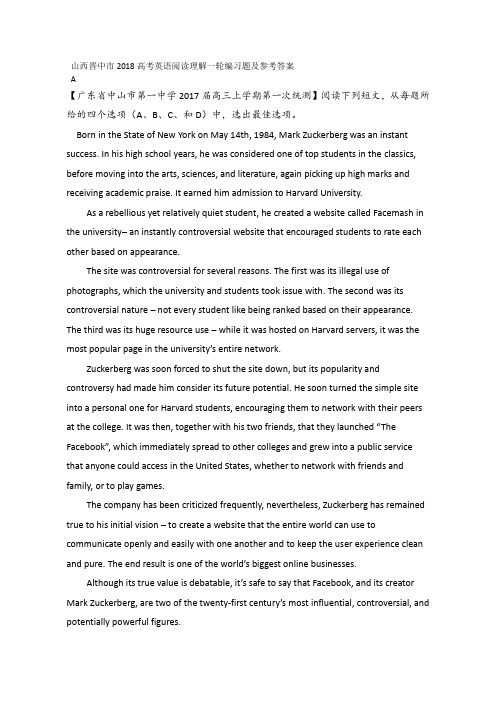
山西晋中市2018高考英语阅读理解一轮编习题及参考答案A【广东省中山市第一中学2017届高三上学期第一次统测】阅读下列短文,从每题所给的四个选项(A、B、C、和D)中,选出最佳选项。
Born in the State of New York on May 14th, 1984, Mark Zuckerberg was an instant success. In his high school years, he was considered one of top students in the classics, before moving into the arts, sciences, and literature, again picking up high marks and receiving academic praise. It earned him admission to Harvard University.As a rebellious yet relatively quiet student, he created a website called Facemash in the university– an instantly controversial website that encouraged students to rate each other based on appearance.The site was controversial for several reasons. The first was its illegal use of photographs, which the university and students took issue with. The second was its controversial nature – not every student like being ranked based on their appearance. The third was its huge resource use – while it was hosted on Harvard servers, it was the most popular page in the university’s entire net work.Zuckerberg was soon forced to shut the site down, but its popularity and controversy had made him consider its future potential. He soon turned the simple site into a personal one for Harvard students, encouraging them to network with their peers at the college. It was then, together with his two friends, that they launched “The Facebook”, which immediately spread to other colleges and grew into a public service that anyone could access in the United States, whether to network with friends and family, or to play games.The company has been criticized frequently, nevertheless, Zuckerberg has remained true to his initial vision – to create a website that the entire world can use to communicate openly and easily with one another and to keep the user experience clean and pure. The end result is one of the world’s biggest online businesses.Although its true value is debatable, it’s safe to say that Facebook, and its creator Mark Zuckerberg, are two of the twenty-first century’s most influential, controversial, and potentially powerful figures.4. When Mark Zuckerberg was a student, he_____________________.A. was often praised by teachers for the website he createdB. had good academic performanceC. alone created a website called FacebookD. encouraged students to set up business like him5. The reason why Zuckerberg shut the site down was probably that__________.A. his website was not popularB. he was doubted for the way he used photographsC. he needed time to reconsider his choiceD. he stole resource on Harvard server6.Which words can best describe Zuckerberg?A. easy-going and smart.B. quiet and shy.C. talented and outgoing.D. rebellious and creative.7. The best title of the passage should be________________.A. Mark Zuckerberg and his FacebookB. The Foundation of FacebookC. A Talent from Harvard UniversityD. The Development of Facebook【名师点睛】抓住文章主线和关键词语,归纳文章中心要注意不是所有的段落都有主题句,有时主题句暗含在句中。
- 1、下载文档前请自行甄别文档内容的完整性,平台不提供额外的编辑、内容补充、找答案等附加服务。
- 2、"仅部分预览"的文档,不可在线预览部分如存在完整性等问题,可反馈申请退款(可完整预览的文档不适用该条件!)。
- 3、如文档侵犯您的权益,请联系客服反馈,我们会尽快为您处理(人工客服工作时间:9:00-18:30)。
山西省晋中市高三1月高考适应性调研考试英语试题第一节(共5小题; 每小题1.5分,满分7.5分)听下面5段对话。
每段对话后有个小题,从题中所给的A、B、C 三个选项中选出最佳选项。
听完每段对话后,你都有10秒钟的时间来回答有关小题和阅读下一小题。
每段对话仅读一遍。
1. Where are they talking most probably?A. In a museum.B. In a cinema.C. In a lab.2. How many swimming classes are there this term?A. Five.B. Eight.C. Thirteen.3. What is Alice worried about?A. Her brother.B. Her final exams.C. Her accident.4 . Who is Jack?A. Jenny’s husband.B. Mary’s husband.C. Jenny’s old colleague.5. Why does the man reject the job?A. It is low-paid.B. It is far from his home.C. It offers no holiday.第二节(共15小题;每小题15分,满分2.5分)听下面5段对话或独白。
每段对话或独白后有几个小题,从题中所给的A、B、C 三个选项中选出最佳选项。
听每段对话或独白前,你将有时间阅读各个小题,每小题5秒钟;听完后,各小题将给出5秒钟的作答时间。
每段对话或独白读两遍。
听第6段材料,回答第6、7题。
6. Why did the woman move?A. To live in a bigger house.B. To live closer to her office.C. To live with nice neighbors.7. How did the woman usually go to work?A. By car.B. By bus.C. On foot.听第7段材料,同答第8、9题。
8. When did Alice get her computer?A. Yesterday morning.B. Yesterday afternoon.C. This morning.9. What is Bob going to do?A. See the doctor.B. Repair the computer.C. Check the Internet. 听第8段材料,回答第10至12题10. When will the man check out?A. Next Thursday.B. Next Wednesday.C. Next Tuesday.11. What kind of room does the man book?A. A single room with a bathroom.B. A double room with a bathroom.C. A double room without a bathroom.12. What can the man do in his room?A. Surf the Internet.B. Have breakfast.C. Do the laundry听第9段材料,回答第13 至16题。
13. What is Mary wearing?A. A black shirt.B. A brown skirt.C. A yellow blouse.14. What do we know about Mary’s grandmother?A. She’s in goodB. She’s going to be 80.C. She has a good memory.15. What should Mary do now?A. Make a wish.B. Cut the cake.C. Blow out the candles.16. What will the man have?A. Some fish.B. Some steak.C. Some cake.听第10段材料,回答第17至20题。
17. What is the function of the chocolate?A. It makes people prettier.B. It makes people happier.C. It makes people younger.18. What is still unknown about the chocolate?A. Its inventors.B. Its price.C. Its color.19. How many bars of chocolate should a person eat a day?A. One.B. Two.C. Three.20. Why does more research need to be done?A. To see if the chocolate is effective.B. To invent better chocolate.C. To attract more volunteers.第二部分阅读理解(共两节,满分60分)第一节(共15小题;每小题3分,满分45分)ADuring the 1800s, African Americans worked long days in the fields of the American South. To ease their labor, they sang “field hollers(号子)” that they had brought from Africa. One person sang a line. Then a group of workers repeated it. The song’s words told of the hardships that people suffered. This call-and -response singing style was also used in churches. African Americans sang joyous religious songs. They clapped their hands and stamped their feet to the music.After the Civil War(1861-1865), the music changed greatly. African American music, from ballads to church music, took new forms. It was also adapted dance music, called “jump-ups”. Then banjos became popular. A blues singer usually played a call and response with the banjo. He or she sang a line and then played the banjo response. By the early 1900s, the guitar had replaced the banjo as the main blues instrument.Northern Mississippi—called the Delta—was the center of blues tradition. By the 1920s, the Delta had many clubs, so-called juke joints. African Americans listened and danced to music in these clubs. Some of the greatest blues men and women performed there.The words of blues songs describe everyday life. They are often very emotional and personal. They tell about sorrow and overwork. They tell about finding or losing love, having money or being poor, being happy or sad and lonely. Blues may use humor to describe life’s struggles and joys.By the 1940s, large numbers of African Americans had left the Delta and moved north to work. Many settled in Chicago. There, a new kind of “electric” or “Chicago” blues began. Many of its themes were thesame, but these blues had electric guitars and harmonicas. The Chicago blues with a strong loud beat was excellent dance music. Chicago blues led to the birth of a new music style—rock and roll.21. What does the underlined word “banjo” in paragraph 2 refer to?A. A blues singer.B. A line in a song.C. A style of dance music.D. A kind of musical instrument.22. What information can we get in paragraph 4?A. The techniques in blues.B. The themes of blues.C. The influence of blues.D. The development of blues.23. According to the text, rock and roll .A. is full of humorsB. was formed in DeltaC. first appeared in churchesD. developed from Chicago blues24. The author’s purpose of writing the text is most likely to .A. informB. persuadeC. instructD. entertainBI am bent at an unnatural angle, my left hand waving a mop across the bathroom floor, my right hand grasping a hair straightener. As I catch sight of myself in the mirror, the stupidity of the situation strikes me. But I go on with them, convinced I’m getting the most from my early morning minutes.We live in a world of multitasking—where the measure of a person is how many jobs they can perform at the same time. Yet, is multitasking a good idea?”We’ve done a number of studies that prove people who multitask frequently suffer a lot, ”Dr Nass Clifford at Stanford University says. “They’re less able to recognize useless information, they’re less able to pay attention, and they are worse at managing their memory.”Psychologist Dr Sherry Turkle, a Massachusetts Institute of Technology professor, holds the view that in some situations, the loss that we get with multitasking is harmless, “But you can’t do serious work this way.” Of course. There are some things we can do simultaneously. We can talk while walking, or eat dinner while watching TV. This is because each task requires a different type of brain activity. So, reading while listening to instrumental music is fine, but the ability to concentrate on words on a page decreases sharply when listening to music with lyrics, because both actions rely on the part of the brain that deals with language.So what about my need to multitask? Perhaps both my hair and my bathroom floor would end up better off if each received some individual attention. Of course they would, but I have to take the first step and learn to self-management my time better. “It takes a huge amount of discipline, and people find it really difficult,” says Dr Nass, “But that doesn’t men it’s not a great thing to do.”25. From what the author does in the morning, we know that she .A. thinks she is wasting timeB. gets a feeling of satisfactionC. wants to save timeD. is enjoying herself26. According to the studies done by the experts at Stanford University, .A. multitasking is not a good ideaB. we can’t do two things at the same timeC. multitasking can improve people’s memoryD. those who are able to multitask are quick-minded27. The underlined word “simultaneously” in paragraph 5 probably means .A. quicklyB. independentlyC. at the same timeD. without difficultyCThe Earth’s temperature is rising. And as it does, springtime phenomena—like the first bloom offlowers—are getting earlier and earlier. But rising temperatures aren’t the only factor. Urban light pollution is also quickening the coming of spring. “So temperature and light are really contributing to a double whammy of making everything earlier. ” Richard Ffrench-Constant, an entomologist at the University of Exeter.He and his colleagues compiled 13 years of data from citizen scientists in the U. K. , who tracked the first bud(芽) burst of four common trees. Turns out, light pollution—from streetlights in cities, and along roads—pushed bud burst a full week earlier. Way beyond what rising temperatures could achieve. This disruptive(干扰性的) timing can ripple through the ecosystem.The caterpillars that feed on trees are trying to match the hatching of their eggs to the timing of bud burst. Because the caterpillars want to feed on the juiciest and least chemically protected leaves. And it’s not just the caterpillars, of course, that are important. But the knock-on effect is on nesting birds, which are also trying to hatch their chicks at the same time that there’s the maximum number of caterpillars. So earlier buds could ultimately affect the survival of birds, and beyond. The findings are in the Proceedings of the Royal Society B.The world’s becoming increasingly urbanized, and light pollution is growing—which Richard says could trick trees into budding earlier and earlier. But smarter lighting—like LEDs that dial down certain wavelengths—could help. “Perh aps the exciting thing is, if we understand more about how light affects this bud burst, we might be able to devise smarter sort of street lighting that has less red components, and therefore less early bud burst. Thus it is possible to keep springtime an actual springtime phenomenon. ” Richard add.28. How did Richard and his colleagues reach the conclusion?A. By analyzing some data.B. By observing nature closely.C. By doing a lot of experiments.D. By keeping track of four common trees.29. Why do the caterpillars hatch eggs at the same time of bud burst?A. To protect young leaves.B. To get high quality food.C. To give birth to healthy babies.D. To avoid being the meals of birds.30. How does Richard feel about the actual springtime phenomenon?A. It’s promising.B. It’s amusing.C. It’s costly.D. It’s challenging.31. What may be the best title for the next?A. The Rising Temperature of the EarthB. Ways of Reducing Urban Light PollutionC. City Lights Quickening the Coming of SpringD. The Effect of the Earlier Spring on the EcosystemDKobe Bryant, the former US National Basketball Association league star, launches a $100 million venture capital fund known as Bryant Stibel at the New York Stock Exchange.Mr Bryant, 37, the former captain of the Los Angeles, retired from basketball earlier last year after a 20-year career. He told The Wall Street Journal he felt he had a talent for identifying entrepreneurs(企业家). Mr Stibel is an entrepreneur and investor(投资者) who founded several companies including . Mr Bryant has invested with Mr Stibel before, but this fund is the first formal partnership between them. The pair are financing the fund themselves. Since 2013, they have invested in 15 companies together including sports website The Players Tribune, video game designer Scopely, and legal services company Legal Zoom. The “Bryant Stibel” fund will invest in tech, media and data companies.Mr Bryant, who was known for his strong work ethic(道德) in basketball, said, “Similar skills are needed for sport and growing a business. It’s the inner belief that a person has that he will bear no matter what the obstacle may be. It’s a strong will that makes the entrepreneur do what he or she truly believes in and truly loves to do .”The pair said the fund would last a few years and look to target companies where they felt they could add vale through their business insight, and not through Mr Bryant’s celebrity(名人). Mr Stibel told TheWall Street Journal, “We don’t want to be in the business of investing in others’ companies, where someone can use Kobe as an endorser(代言人). That’s not interesting. The point is to add real value.”32. What can we know about Bryan Stibel?A. It has invested in tech and media.B. It was created the moment Kobe retired.C. Its fund is provided by Kobe and Stible.D. It is the first cooperation between Kobe and Stible.33. What does Kobe think matters in running a business?A. Enthusiasm.B. Determination .C. Partnership .D. Intelligence.34. Why did the pair want to set up the fund?A. To add value to some companies.B. To invest in the companies in trouble.C. To take advantage of Mr Kobe’s celebrity.D. To contribute to the development of sports.35. What type of writing is this text?A. A sport event.B. A news report.C. An interview.D. A biography第二节(共5小题;每小题3分,满分15分)根据短文内容,从短文后的选项中选出能填入空白的最佳选项。
